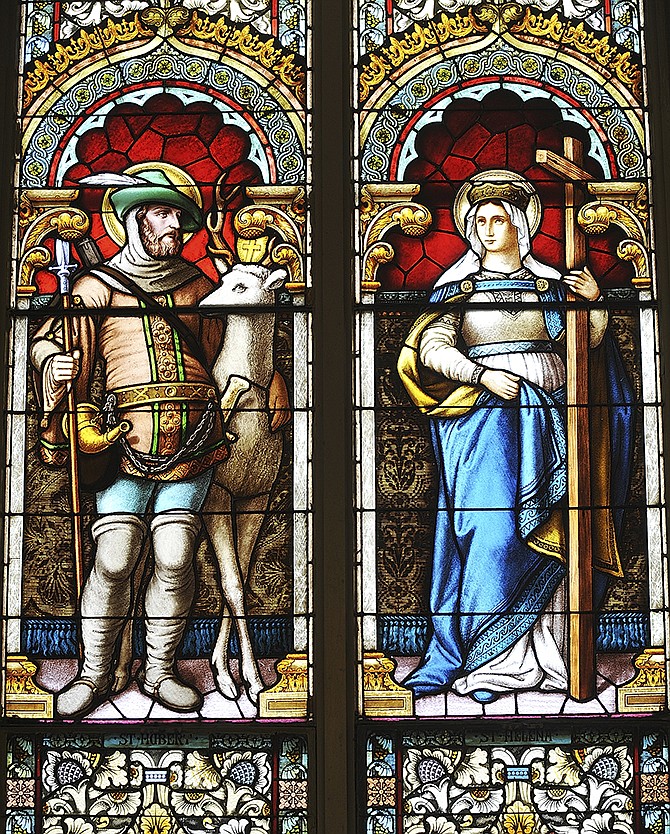Walk into any church like a curious child, and you may caper in awe under giant sun-shot characters in glass surrounding a ceiling so high it touches heaven. There's a feeling of higher places, bigger lives and longer history.
Down to earth again, you may spy a mouse, a spider, a goose, a man clutching a wheel or a shovel, dragons, crowns, scepters and other images that hint at treasured stories.
These are the colorful images of Catholic churches in Osage County.
According to Robyn Burnett and Ken Luebbering, authors of the 2000 book "Gospels in Glass: Stained Glass Windows in Missouri Churches," the Frei Company of St. Louis produced works of art in stained glass among the most beautiful in the United States. Those in Osage County trace heritage from Germany, exhibiting immigrant community influences and the evolution of stained-glass windows in the United States after 1900.
The Frei Company is famous for creating stained glass using traditional medieval methods. Sacred Heart Catholic Church in Rich Fountain displays Frei family work from the 1920s. It's also a gallery of saints who stepped off the boat with German immigrant farmers, depicting well-known and dear stories from their homeland.
There's St. Gertrude, the seventh-century abbess, always shown with a mouse crawling up her staff. She is the patron saint of patience. The devil, taking the form of a mouse, is said to have gnawed through her yarn on a spinning wheel. She is also credited with saving farmers' crops from a plague of mice and rats in the lower Rhine valley, now western Germany and Belgium, in 1822.
St. Isidore, in another window, wears a sun hat and holds a shovel. These days he would have to be on a tractor, as he is patron saint of farmers. It is said he lived a laborer's life, so devout that when he died his body remained pristine, and that angels plowed his fields while he was in church.
St. Joseph Catholic Church in Westphalia installed Frei stained glass in 1905, choosing saints to surround the congregation years before the church in Rich Fountain. Saints Gertrude and Isidore are there, too. A few windows over, St. Hubert meets a stag in the woods while hunting. The story goes that Hubert needed a little help remembering to honor the Lord. Adorned with a glowing cross between his antlers, the stag is under Hubert's arm like an old friend. Hubert is patron saint of hunters, another vital occupation brought from the old country.
Down the nave from Hubert is St. Martin, always depicted with a goose in hand because his feast day is a traditional November butchering time in medieval communities. St. Ambrose, nearby, has a beehive, to symbolize wisdom - he was known as "the honey-tongued doctor" in his time. Bees also are emblems of strong faith, which is why Ambrose appears at St. Joseph church as patron saint of beekeepers even though he never husbanded a bee in his entire life.
South of Westphalia is Holy Family Church in Freeburg, the last Missouri church built in the European style. Tall stained-glass windows, installed in 1952, celebrate the 50th anniversary of the parish in 1954. Only four original windows from 1921 remain over the sanctuary, depicting moments in the life of Christ. The stained glass design has a modern, post-Art Nouveau feeling, but harks forward to design common in windows of newer churches built in the late 1960s.
Holy Family's large stained glass depicts repeated images of communion symbols from St. John's gospel. The windows are predominantly clear or pastel in contrast to more ornate, sometimes dark, traditional windows. They are decorative more than story-telling, but bathe people in beautiful and inspiring light.
Windows over the altar in Freeburg, jewel-like with cobalt blue backgrounds, hint at Visitation of the Blessed Virgin Mary Catholic Church down the road in Vienna. Like Holy Family's, Vienna's church windows do not picture saints, but instead tell the story of the life and death of Jesus of Nazareth. Called narrative windows, these are framed in opalescent glass (like that developed by Tiffany) surrounding large expanses of painted background with characters in traditional, leaded stained glass in the foreground.
"Stained-glass windows using three different traditions - medieval (17th century), Netherlands (painted backgrounds) and opalescent glass (very American) - are relatively rare," Luebbering said. Burnett added that the backgrounds introduce great drama with directional light plays like those in a Rembrandt painting. The windows, installed in 1907, were made by the Ford Bothers of Minnesota.
Visitation church surrounds the community of the faithful with something akin to a Shakespeare play - it teaches; and, at the same time, it is populated with known characters playing out known stories from the New Testament.
According to the authors, Catholic churches are often planned by church hierarchy. Even so, Mid-Missouri churches founded by the Rev. Ferdinand Helias and served by Jesuit priests in the early years of Osage County Catholicism seem to breathe their German ancestry through stained-glass windows.
Helias, from Belgium, was directly associated with the original church buildings in both Westphalia and Rich Fountain. Maybe he had a hand influencing the characters in glass decades later. Or maybe hard-headed German immigrant farmers just decided they needed their favorite saints and stories to make it through planting and harvesting.
Information from "Gospels in Glass: Stained Glass Windows in Missouri Churches" by Robyn Burnett and Ken Luebbering was used to compile this article.

